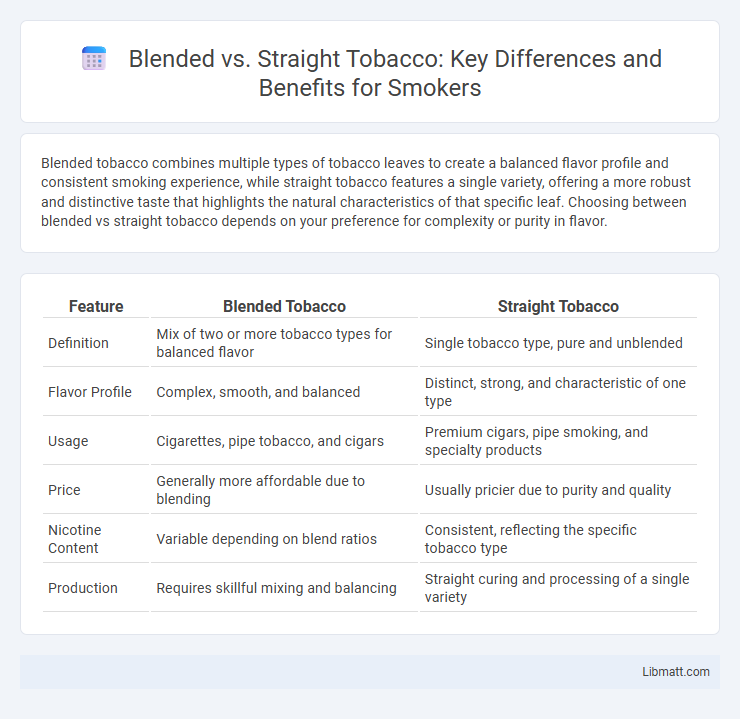Blended tobacco combines multiple types of tobacco leaves to create a balanced flavor profile and consistent smoking experience, while straight tobacco features a single variety, offering a more robust and distinctive taste that highlights the natural characteristics of that specific leaf. Choosing between blended vs straight tobacco depends on your preference for complexity or purity in flavor.
Table of Comparison
| Feature | Blended Tobacco | Straight Tobacco |
|---|---|---|
| Definition | Mix of two or more tobacco types for balanced flavor | Single tobacco type, pure and unblended |
| Flavor Profile | Complex, smooth, and balanced | Distinct, strong, and characteristic of one type |
| Usage | Cigarettes, pipe tobacco, and cigars | Premium cigars, pipe smoking, and specialty products |
| Price | Generally more affordable due to blending | Usually pricier due to purity and quality |
| Nicotine Content | Variable depending on blend ratios | Consistent, reflecting the specific tobacco type |
| Production | Requires skillful mixing and balancing | Straight curing and processing of a single variety |
Introduction to Blended and Straight Tobacco
Blended tobacco combines two or more types of tobacco leaves, such as Virginia, Burley, and Oriental, creating a balanced flavor profile with enhanced complexity and smoothness. Straight tobacco consists of a single variety, offering a purer, more intense taste that highlights the specific characteristics of that leaf. Your choice between blended and straight tobacco impacts the smoking experience, depending on whether you prefer nuanced flavors or a more robust, unaltered tobacco essence.
Defining Blended Tobacco
Blended tobacco consists of a mix of different types of tobacco leaves, such as Virginia, Burley, and Oriental, each contributing unique flavors and burning characteristics. This combination creates a balanced taste profile with enhanced complexity compared to straight tobacco, which is made from a single type of leaf. Your choice between blended and straight tobacco depends on whether you prefer a nuanced flavor or the pure essence of one tobacco variety.
What is Straight (Single-Origin) Tobacco?
Straight (single-origin) tobacco refers to tobacco leaves harvested from a specific region or farm, preserving unique flavor profiles and characteristics inherent to that location. Unlike blended tobacco, which combines leaves from multiple origins to create a balanced taste, straight tobacco highlights the distinct aroma, strength, and texture of its singular source. This type of tobacco appeals to aficionados seeking authenticity and a pure experience of the tobacco's geographical terroir.
Key Differences Between Blended and Straight Tobacco
Blended tobacco combines various types of tobacco leaves to create a balanced flavor profile, while straight tobacco uses a single type, preserving its pure, distinct taste. Blended tobacco offers consistency and complexity by mixing Virginia, Burley, and Oriental tobaccos, whereas straight tobacco highlights the unique characteristics of one variety, such as pure Virginia or Latakia. These differences impact flavor, aroma, and smoking experience, catering to diverse preferences among pipe smokers and cigar aficionados.
Flavor Profiles: Blended vs Straight Tobacco
Blended tobacco combines various types like Virginia, Burley, and Oriental tobaccos to create a complex flavor profile with balanced sweetness, mild bitterness, and rich aromatic notes. Straight tobacco features a single type, offering a purer, more distinct taste that highlights the unique characteristics of that specific leaf, such as the grassy sweetness of Virginia or the earthy robustness of Burley. Flavor intensity and smoothness vary significantly between blended and straight tobaccos, appealing to different preferences and smoking experiences.
Popular Brands Using Blended and Straight Tobacco
Popular brands using blended tobacco include Marlboro and Camel, known for their mix of Virginia, Burley, and Oriental tobaccos that create a balanced flavor profile. Straight tobacco brands such as American Spirit emphasize single-origin tobaccos, often offering 100% additive-free cigarettes with a robust and natural taste. These distinctions in tobacco blends cater to diverse consumer preferences, influencing brand loyalty and market segmentation.
Production Processes Compared
Blended tobacco involves combining different types of tobacco leaves, such as Virginia, Burley, and Oriental, through a carefully controlled fermentation and curing process to balance flavor and aroma. Straight tobacco is produced from a single type of tobacco leaf, often using specific curing methods like flue-curing or air-curing to highlight the natural characteristics of that variety. The production process for blended tobacco demands precise mixing and aging to achieve consistency, while straight tobacco production emphasizes purity and preservation of the leaf's inherent qualities.
Smoking Experience: Blended vs Straight Tobacco
Blended tobacco offers a smoother smoking experience by combining various tobacco types, enhancing flavor complexity and reducing harshness, while straight tobacco provides a more robust and intense taste true to a single tobacco variety. Your smoking preference will determine which suits you best, as blended tobacco caters to those seeking a balanced and mild profile, whereas straight tobacco appeals to enthusiasts who favor strong, unadulterated flavors. The difference in combustion and aroma between the two also significantly impacts the overall satisfaction of the smoking ritual.
Pros and Cons of Each Tobacco Type
Blended tobacco combines various types of tobacco leaves, offering a balanced flavor and smoother burn, but it may contain additives that affect purity. Straight tobacco, made from a single type of leaf, delivers a stronger, more authentic taste, though it can be harsher and less forgiving for beginners. Understanding these pros and cons helps you choose the right tobacco to match your taste preferences and smoking habits.
Choosing the Right Tobacco for Your Preferences
Blended tobacco combines different types of leaves, offering a complex flavor profile that appeals to smokers seeking variety and balance. Straight tobacco consists of a single type of leaf, providing a more distinct and robust taste ideal for enthusiasts who prefer purity and intensity. Selecting the right tobacco depends on whether you prioritize flavor complexity from blends or the bold character of straight tobacco.
blended vs straight tobacco Infographic

 libmatt.com
libmatt.com